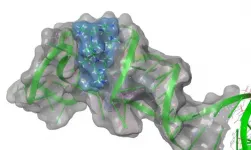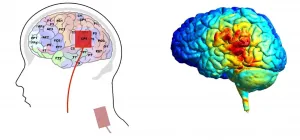(Press-News.org) PITTSBURGH--A smile that lifts the cheeks and crinkles the eyes is thought by many to be truly genuine. But new research at Carnegie Mellon University casts doubt on whether this joyful facial expression necessarily tells others how a person really feels inside.
In fact, these "smiling eye" smiles, called Duchenne smiles, seem to be related to smile intensity, rather than acting as an indicator of whether a person is happy or not, said Jeffrey Girard, a former post-doctoral researcher at CMU's Language Technologies Institute.
"I do think it's possible that we might be able detect how strongly somebody feels positive emotions based on their smile," said Girard, who joined the psychology faculty at the University of Kansas this past fall. "But it's going to be a bit more complicated than just asking, 'Did their eyes move?'"
Whether it's possible to gauge a person's emotions based on their behavior is a topic of some debate within the disciplines of psychology and computer science, particularly as researchers develop automated systems for monitoring facial movements, gestures, voice inflections and word choice.
Duchenne smiles might not be as popularly known as Mona Lisa smiles or Bette Davis eyes, but there is a camp within psychology that believes they are a useful rule of thumb for gauging happiness. But another camp is skeptical. Girard, who studies facial behavior and worked with CMU's Louis-Phillippe Morency to develop a multimodal approach for monitoring behavior, said that some research seems to support the Duchenne smile hypothesis, while other studies demonstrate how it fails.
So Girard and Morency, along with Jeffrey Cohn of the University of Pittsburgh and Lijun Yin of Binghamton University, set out to better understand the phenomenon. They enlisted 136 volunteers who agreed to have their facial expressions recorded as they completed lab tasks designed to make them feel amusement, embarrassment, fear or physical pain. After each task, the volunteers rated how strongly they felt various emotions.
Finally, the team made videos of the smiles occurring during these tasks and showed them to new participants (i.e., judges), who tried to guess how much positive emotion the volunteers felt while smiling.
A report on their findings has been published online by the journal Affective Science.
Unlike most previous studies of Duchenne smiles, this work sought spontaneous expressions, rather than posed smiles, and the researchers recorded videos of the facial expressions from beginning to end rather than taking still photos. They also took painstaking measurements of smile intensity and other facial behaviors.
Although Duchenne smiles made up 90% of those that occurred when positive emotion was reported, they also made up 80% of the smiles that occurred when no positive emotion was reported. Concluding that a Duchenne smile must mean positive emotion would thus often be a mistake. On the other hand, the human judges found smiling eyes compelling and tended to guess that volunteers showing Duchenne smiles felt more positive emotion.
"It is really important to look at how people actually move their faces in addition to how people rate images and videos of faces, because sometimes our intuitions are wrong," Girard said.
"These results emphasize the need to model the subtleties of human emotions and facial expressions," said Morency, associate professor in the LTI and director of the MultiComp Lab. "We need to go beyond prototypical expression and take into account the context in which the expression happened."
It's possible, for instance, for someone to display the same behavior at a wedding as at a funeral, yet the person's emotions would be very different.
Automated methods for monitoring facial expression make it possible to examine behavior in much finer detail. Just two facial muscles are involved in Duchenne smiles, but new systems make it possible to look at 30 different muscle movements simultaneously.
Multimodal systems such as the ones being developed in Morency's lab hold the promise of giving physicians a new tool for assessing mental disorders, and for monitoring and quantifying the results of psychological therapy over time.
"Could we ever have an algorithm or a computer that is as good as humans at gauging emotions? I think so," Girard said. "I don't think people have any extrasensory stuff that a computer couldn't be given somewhere down the road. We're just not there yet. It's also important to remember that humans aren't always so good at this either!"
INFORMATION:
The National Science Foundation and the National Institutes of Health supported this research.
An international research team has developed a fast and affordable quantum random number generator. The device created by scientists from NUST MISIS, Russian Quantum Center, University of Oxford, Goldsmiths, University of London and Freie Universität Berlin produces randomness at a rate of 8.05 gigabits per second, which makes it the fastest random number generator of its kind. The study published in Physical Review X is a promising starting point for the development of commercial random number generators for cryptography and complex systems modeling.
INFORMATION: ...
ATHENS, Ohio (Jan. 20, 2021) - While the world awaits broad distribution of COVID-19 vaccines, researchers at Ohio University just published highly significant and timely results in the search for another way to stop the virus -- by disrupting its RNA and its ability to reproduce.
Dr. Jennifer Hines, a professor in the Department of Chemistry and Biochemistry, along with graduate and undergraduate students in her lab, published the first structural biology analysis of a section of the COVID-19 viral RNA called the stem-loop II motif. This is a non-coding section of the RNA, which means that it is not translated into a protein, but it is likely key to the ...
LEXINGTON, Ky. (January 20, 2021) - More than 5.7 million Americans live with Alzheimer's disease and that number is projected to triple by 2050. Despite the growing number there is not a cure. Florin Despa a professor with the University of Kentucky's department of pharmacology and nutritional sciences says, "The mechanisms underlying neurodegenerative diseases are largely unknown and effective therapies are lacking." That is why numerous studies and trials are ongoing around the world including at the University of Kentucky. One of those studies by University of Kentucky researchers was recently published in Alzheimer's & Dementia: Translational Research & Clinical Interventions. It is the ...
Older adults are managing the stress of the coronavirus pandemic better than younger adults, reporting less depression and anxiety despite also experiencing greater general concern about COVID-19, according to a study recently published by researchers at the UConn School of Nursing.
Their somewhat paradoxical findings, published last month in the journal Aging and Mental Health, suggest that although greater psychological distress has been reported during the pandemic, older age may offer a buffer against negative feelings brought on by the virus's impact.
"When you think about older adulthood, oftentimes, there are downsides. For example, with regard to physical well-being, we don't recover as well from injury or ...
Not long after the sun goes down, pairs of burying beetles, or Nicrophorus orbicollis, begin looking for corpses.
For these beetles, this is not some macabre activity; it's house-hunting, and they are in search of the perfect corpse to start a family in. They can sense a good find from miles away, because carrion serves as a food source for countless members of nature's clean-up crew. But because these beetles want to live in these corpses, they don't want to share their discovery. As a result, burying beetles have clever ways of claiming their decaying prize all for themselves. In new research published in The American Naturalist, researchers from UConn and The University of Bayreuth have found these beetles recruit microbes to help throw rivals off the scent.
Immediately following ...
The NFL playoffs are underway, and fans are finding ways to simulate tailgating during the COVID-19 pandemic. Football watch parties are synonymous with eating fatty foods and drinking alcohol. Have you ever wondered what all of that eating and drinking does to your body?
Researchers from the University of Missouri School of Medicine simulated a tailgating situation with a small group of overweight but healthy men and examined the impact of the eating and drinking on their livers using blood tests and a liver scan. They discovered remarkably differing responses in the subjects.
"Surprisingly, we found that in overweight men, after an afternoon of eating and drinking, how their bodies reacted to food and drink was not uniform," said Elizabeth Parks, PhD, professor of nutrition and ...
University of Arizona researchers read between the lines of tree rings to reconstruct exactly what happened in Alaska the year that the Laki Volcano erupted half a world away in Iceland. What they learned can help fine-tune future climate predictions.
In June 1783, Laki spewed more sulfur into the atmosphere than any other Northern Hemisphere eruption in the last 1,000 years. The Inuit in North America tell stories about the year that summer never arrived. Benjamin Franklin, who was in France at the time, noted the "fog" that descended over much of Europe in the aftermath, and correctly reasoned that it led to an unusually cold winter on the continent.
Previous analyses of annual tree rings have shown that the entire 1783 growing season for the spruce ...
A meteorite that fell in northern Germany in 2019 contains carbonates which are among the oldest in the solar system; it also evidences the earliest presence of liquid water on a minor planet. The high-resolution Ion Probe - a research instrument at the Institute of Earth Sciences at Heidelberg University - provided the measurements. The investigation by the Cosmochemistry Research Group led by Prof. Dr Mario Trieloff was part of a consortium study coordinated by the University of Münster with participating scientists from Europe, Australia and the USA.
Carbonates are ubiquitous rocks on Earth. They can be found in the mountain ranges of the Dolomites, the chalk cliffs on the island of Rügen, and in the coral reefs of the ...
Transcranial direct current stimulation (tDCS) is a non-invasive method of brain stimulation, in which electrodes are applied over certain places on the scalp, creating a weak electric field. It is currently used for a variety of purposes: from treating depression and pain syndromes to better acquisition of new words and even sports techniques.
During stimulation, the active electrode can transmit a positive or negative electrical charge. In the former case, this stimulation is called 'anodal'; in the latter one, it is called 'cathodal'. Researchers believe that anodal tDCS generally leads to depolarisation of neurons, which increases the likelihood of their excitation when new information arrives. Cathodal ...
As the United States struggles to control record-breaking increases in COVID-19 infections and hospitalizations, the roll-out of two approved vaccines offers tremendous hope for saving lives and curbing the pandemic. To achieve success, however, experts estimate that at least 70 to 90 percent of the population must be inoculated to achieve herd immunity, but how can we ensure folks will voluntarily receive a vaccine?
Both vaccines require two injections. Pfizer-BioNTech's second dose must be given 21 days after the first and Moderna's second dose must be administered 28 days after the first. While public health and infectious disease experts have discussed strategies to enhance adherence, including the potential use of financial incentives, ...





